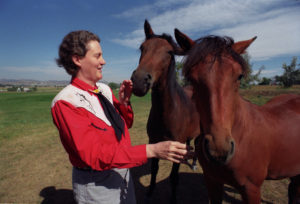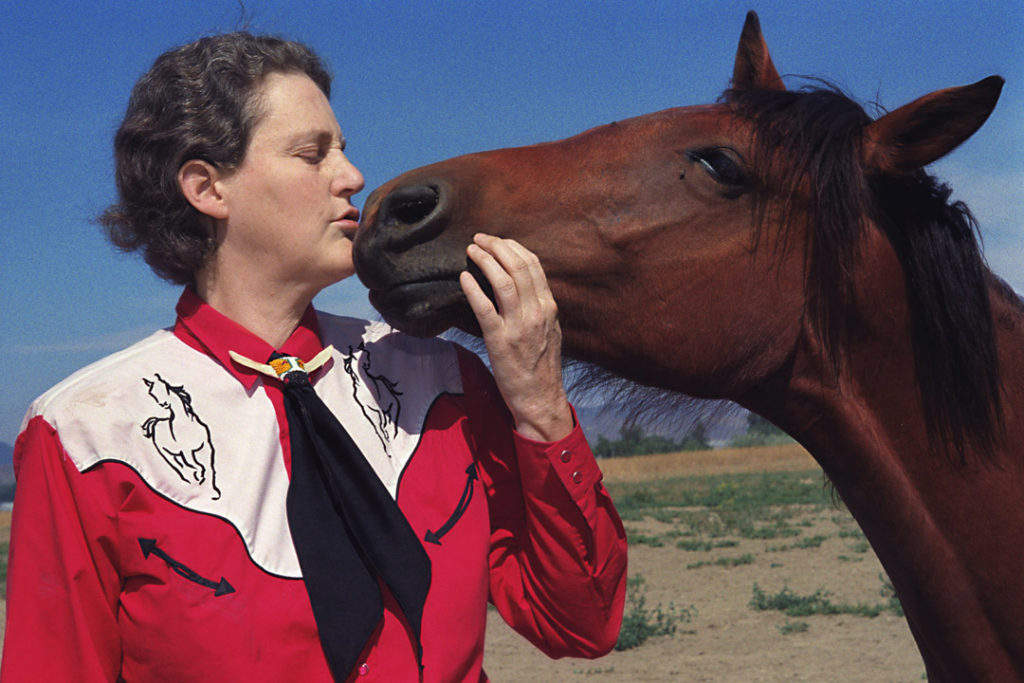How Horses Think with Dr. Temple Grandin

Dr. Temple Grandin teaches animal behavior classes at Colorado State University and has written several books on how animals think. Photo credit: Rosalie Winard; used with permission.
Horseshoeing is a complex, skilled trade that requires precision work. A good farrier will seek to make the horse as comfortable as possible to ensure his/her ability to do the job accurately. When a horse is uncomfortable and shifting around, it is difficult to trim a foot accurately and to apply a horseshoe. Unlike auto mechanics, farriers don’t get to turn the engine off to do their job!
Understanding how horses think makes the job of a farrier much easier. Studying horse behavior will pay dividends for the farrier who wants to have a long, successful career in the industry. I have had former students say to me, “I was able to get an account shoeing horses at this barn, simply because the owners liked the way I treated their horses.”
Dr. Temple Grandin has done more to bring attention to this subject than any other professional in the field. She says that she has a unique perspective on how animals think because of her diagnosis of autism at a young age. She has written books and articles, taught at the university level, spoken on the subject at numerous conferences. An HBO film was made about her life. Dr. Grandin thinks in pictures. She understands that horses, and other animals, also perceive the world through sensory-based experiences.
Recently, I interviewed Dr. Grandin about her views on how horses think and how people learn. She made it clear, up front, that her experience is unique to her. Not everyone with autism necessarily sees things the way she does, but she attributes her ability to be a photorealistic thinker to her autism.
I asked what farriers can do to ensure positive experiences with horses during the farrier’s visit. She said, “Let’s make sure that the first time [the horse] is introduced to the farrier that nothing bad happens. If an experience with something new is really bad, you can get a fear memory that can cause problems with horseshoeing for the life of the horse…so I would want to hire a farrier that is really patient.” Dr. Grandin explained that a horse handler can work with a young horse by picking up the feet before the farrier ever gets there.
Sometimes bad experiences can happen that are beyond the farrier’s control. If a horse has had a bad experience associated with horseshoeing, Dr. Grandin said, “Sensory things are specific, so one thing you might try if a horse had a bad experience with a farrier, is a totally new location to do the horseshoeing because oftentimes animals have location-specific fears.”
As we talked about how horses think and experience the world, the conversation also led to how people think and learn. Understanding ourselves is such an important part of working with animals. Dr. Grandin has some fascinating insights into the differences in how people think.
Dr. Grandin talks about four different types of thinkers: photorealistic visual thinkers (drawing), pattern thinkers (math and music), verbal fact thinkers (reading), and auditory thinkers (listening).
Everyone may have combinations of these types of thinking, but usually one is more dominant. Dr. Grandin explained, “You can think of it like a musical mixing board, with some dials turned up louder than others.” I asked her if those dials can be moved; if people can change the way they learn or think. She said, “You can change things somewhat, but let’s say ‘visual thinking’ is on a scale of 1 to 10; I’m a 10 and let’s say a verbal thinker is a 1. Well you can move the volume control a little bit on the music mixing board, but you can’t go from one end to the other. A lot of people are much more in the middle.”
This has caused me to evaluate how I think. I realize that I am a very visual thinker with some things. When trimming or shaping shoes, I am thinking exclusively in pictures. Things seem to shift in my mind when I play the piano or the guitar. I have never been able to read music very well, and it is very difficult for me to “play by ear,” but patterns do make sense to me in music. Patterns also seem to extend to the process of shoeing a horse and shaping shoes; following the same sequence of tasks each time. I like to listen to audiobooks and podcasts more than I like to read text. I think this is because I can visualize what is happening as it is being spoken to me. I can do the same with text, but it takes longer for my mind to convert the words into images.
Realizing that these different types of thinking exist can help us to evaluate how we each learn new concepts. It can also help us understand why some people may have trouble working with horses. Dr. Grandin said, “If you have someone who is an extreme word thinker, they might have some issues with figuring out how a horse or a dog, or some other animal, would think. Animals live in a sensory-based world so they are very sensitive to tone of voice, smells…its sensory based, not word based, so you have to get away from verbal language.”
People can learn to see what animals are seeing. For Dr. Grandin, being able to do this comes naturally. In order to understand where cattle might be afraid to go through a chute, she ran through the chute to experience what the cattle would be experiencing, and to see what the cattle would be seeing.
Studying Dr. Grandin’s work and books can help people see what they should be looking for. In many of Dr. Grandin’ s lectures, she shows a slide of a cow pausing on a rubber mat. The text of the slide is about non-slip floors, so verbal thinkers tend to think that is where their attention should be directed. Visual thinkers, however, immediately observe that the cow is looking at a sunbeam on the floor! People can increase their powers of observation by learning what to look for.
According to Dr. Grandin, it is not necessary for everyone to be able to see things the same way. One way of thinking is not better than another; just different. Everyone has their own dominant way of thinking and people should learn what that is, and then develop it. Different ways of thinking are a benefit; not a disadvantage! When different-minded people work together, great things can be accomplished.
This is particularly true with veterinarians and farriers. The relationship between the two professions has sometimes gotten the reputation for being strained because of the differences in thinking. However, when both professionals bring their specialized view to the equation, and value each other’s opinion, the horse is the one that benefits.
Taking time to learn about how we think, as well as how horses think, can help us be better at our job. For those who are visual thinkers and enjoy working with their hands, horseshoeing is a skilled trade that is complex and rewarding. It’s a viable option as a career! According to Dr. Grandin, “People are always going to like horses. Horseshoeing is a good thing to learn. Find a skill that you can get really good at that other people want. The hands-on things are not going to go away.”
You can listen to the whole interview with Dr. Temple Grandin on the Farrier Focus podcast here.
Related Posts
-
The future will bring the foot care industry a combination o...Aug 23, 2010 / 0 comments
-
Recently I was discussing the state of the farrier business ...Jul 26, 2012 / 0 comments
-
These last few weeks, I have been working in the tractor in ...Aug 08, 2019 / 0 comments
Blog Categories
- Anatomy
- Best Business Practices
- Conformation
- Current Events
- Customer Service
- Draft Horse Shoeing
- Equine Soundness
- Essential Anatomy Kit
- Farrier Careers
- Farrier training
- Foal soundness
- Horse Care
- Horse Foot Care
- Horse Owner Tips
- Horsemanship
- Horseshoeing
- Horseshoeing History
- Iron and Forge Work
- Student Spotlight
- Uncategorized
- Veterinary Care
Blog Archives
Contact Us
Butler Professional Horseshoeing School
495 Table Road
Crawford, NE 69339
(800) 728-3826
jacob@dougbutler.com
Subscribe to Our Blog
Get Our Free e-Book!
If you think you want to become a farrier (or know someone who does), this book can help you make that decision. Horse owners will learn the importance of choosing a qualified farrier and how to select the “right” one.
[ Get the e-Book Now! ]
- Follow:

